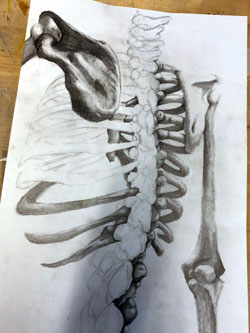Josh is in the building. More specifically, in art teacher Tonya Woods’ classroom.
The Thornapple Area Enrichment Foundation approved a grant request last spring so students have an anatomically correct reference for how the bones connect, their shapes and positioning. Students can also inspect how joints are formed and how they move, Woods said.

“Bones are traditionally used for shading and composition lessons and are a tool to work up to figure drawing,” Woods said. “We’re using this skeleton to learn about the human structure and how to draw people.”
In addition to being a model for the high school art class, the skeleton, named “Josh” by students, inspired a recent field trip to see the Bodies Revealed exhibit at the Grand Rapids Public Museum, and lessons on human anatomy throughout the district.
Student Impact
Senior Kaylyn Beard was so inspired by the introduction of the skeleton to her classroom that she decided to develop an independent study for next semester around the topic of anatomy and physiology of animals and humans.
The independent study will coincide with Kaylyn’s dual enrollment classes at Grand Rapids Community College.
“I find myself very interested in how life functions at a molecular level, as well as at a much larger scale,” Kaylyn said. “In addition to loving biology, I’ve always had an affinity for art. It’s always been a tool to help manage my energy, and it keeps me focused on what’s being taught.”
Having an accurate model of a human skeleton in the classroom is a unique opportunity for Thornapple Kellogg students, Kaylyn said.

“Having a reference is essential in art, or else you’re left floundering and guessing,” she said. “It helps us quantify the human form and better convey it through artwork, and get a better understanding of ourselves on a structural level.”
Previously, the art department borrowed a different skeleton from the biology department.
“Luckily we had staff that was willing to share, but it was not ideal,” Woods said. “This allows us to use the skeleton more often, for more projects.”
She thinks the art department’s use of the skeleton model will evolve, and is thankful for the grant funding. “Art is often a quiet talent that isn’t in the headlines as much,” she said. “The support from our community is imperative.”









